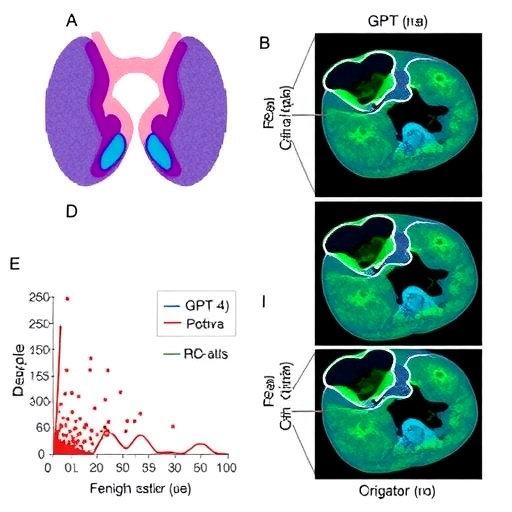
In recent years, the field of neuroanatomy has seen a resurgence of interest in understanding how sex differences manifest in the brain across species. A groundbreaking study by Pham et al. offers an unprecedented glimpse into this complex domain, exploring neuroanatomical covariance from both human and murine perspectives. The implications of this research extend far beyond the academic realm, unlocking potential insights into gender-specific neurological disorders and treatment approaches. Central to this study is the concept of neuroanatomical covariance, a phenomenon that refers to how different brain structures may vary together, often influenced by biological sex, environmental factors, or both.
The findings of this study are particularly notable given the evolutionary significance of understanding sex differences in the brain. While traditionally regarded as a niche area of study, the recognition of these differences is becoming increasingly vital; they may underpin varying susceptibilities to conditions such as autism spectrum disorder and depression. With this investigation, the authors aim to bridge the gap between human and animal studies, asserting that a cross-species approach could shed light on fundamental principles governing brain variation. Human brains and mouse brains share astonishing similarities in structure and function, making mice invaluable models in neuroscientific research.
Employing a combination of advanced imaging techniques and statistical analyses, the researchers meticulously mapped out the neuroanatomical features of both sexes within the studied cohorts. Their approach included the use of magnetic resonance imaging (MRI) and machine learning algorithms, facilitating a holistic view of the brain’s architecture. This detailed examination allowed for the identification of significant covariance patterns in brain regions relevant to cognitive and emotional processing. Such intricate mapping highlights how neuroanatomical features may correlate, revealing essential differences that could influence behavioral outcomes in males versus females.
The study’s cross-species analysis brings forth compelling discussions regarding the underlying biologic mechanisms that dictate these differences. By comparing human neuroanatomy with that of mice, the research establishes a comparative framework that emphasizes the evolutionary underpinnings of sex differences in the brain. This perspective opens avenues for understanding how physiological and molecular factors contribute to cognitive functions. The authors propose that these sex-specific traits are products of both genetic predispositions and environmental influences that shape brain development.
One pivotal observation from this study is the variation in regional brain volume and density between sexes. Notably, structures such as the hippocampus and amygdala exhibited significant covariance differences, which are critical regions for learning, memory, and emotional processing, respectively. The authors suggest that these anatomical variances could reflect inherent differences in behavioral tendencies, with males typically exhibiting more risk-taking behaviors and females showing a greater orientation towards social cognition.
Moreover, Pham et al. delve into the role of hormones in shaping these structural differences. Estrogen and testosterone are hormones known to influence neurodevelopment and may account for the observed disparities. The interplay between these hormones and brain structure is a complex dance that can lead to varied cognitive outcomes across sexes. The modulation of neuroanatomical features by sex hormones further signifies the need for tailored approaches in clinical psychology and neurology, specifically for conditions where gender plays a crucial role.
Another important aspect of the research is its potential application in translational medicine. By understanding neuroanatomical covariance in a cross-species framework, there may be opportunities to better understand human diseases that show sex-based prevalence. For instance, disorders like Alzheimer’s disease and schizophrenia exhibit different statistical incidence and progression rates between men and women. Uncovering the anatomical correlates of these conditions may pave the way for sex-specific therapeutic interventions, fostering more effective treatment strategies that acknowledge the biological underpinnings tied to sex differences.
The study also prompts discussions about how societal factors interact with biological predispositions. Culture, upbringing, and personal experiences undoubtedly influence cognitive and behavioral development, but the intricate relationship between these influences and biological sex differences is still not fully understood. This research opens up a wide array of potential avenues for further inquiry, particularly in exploring how life experiences might shape neuroanatomy within the frameworks established by biological sex.
As we venture further into the world of neuroanatomy and behavioral science, the findings of Pham et al. propel us toward a more nuanced understanding of how sex differences manifest in the brain. This investigation challenges existing paradigms and encourages future studies to adopt a more integrative approach. By embracing a cross-species methodology, researchers can uncover the variations and commonalities that govern brain structure and function in both humans and animals.
As awareness grows regarding the importance of considering sex as a biological variable in research, the academic community is steadily moving towards drawing connections between neuroanatomy, cognition, and mental health. Pham et al.’s study reinforces the urgency for future research to prioritize these dimensions, promoting a more comprehensive understanding of the phenomena at play. By illuminating the neuroanatomical landscape of sex differences, we are one step closer to unraveling the complexities of the human brain.
The impact of this research could extend beyond academia, having repercussions in education, public health, and policy-making. By equipping educators and mental health professionals with knowledge about sex differences in brain structure, we can better tailor programs aimed at optimizing learning and emotional well-being. Furthermore, policymakers may benefit from a deeper understanding of these variations, leading to improved public health initiatives that are cognizant of gender-specific needs.
In conclusion, the cross-species analysis of neuroanatomical covariance presented by Pham et al. marks a significant advancement in our understanding of sex differences in the brain. The researchers have woven a complex narrative that not only connects humans to their murine counterparts but also highlights the dire need for more nuanced approaches in neuroscience. As we continue to explore the landscape of neuroanatomy and its associations with behavior and health, it is imperative to consider how sex differences inform our interpretations of data and subsequent applications in clinical contexts. The dialogue ignited by this study will undoubtedly inspire future research, propelling the scientific community toward more inclusive and representative explorations of the brain.
Subject of Research: Neuroanatomical covariance sex differences in humans and mice
Article Title: A cross-species analysis of neuroanatomical covariance sex differences in humans and mice
Article References:
Pham, L., Guma, E., Ellegood, J. et al. A cross-species analysis of neuroanatomical covariance sex differences in humans and mice. Biol Sex Differ 16, 47 (2025). https://doi.org/10.1186/s13293-025-00728-1
Image Credits: AI Generated
DOI: 10.1186/s13293-025-00728-1
Keywords: neuroanatomy, sex differences, covariance, human brain, mouse brain, MRI, hormones, neurodevelopment, gender-specific disorders, translational medicine, cognitive outcomes.
Tags: autism spectrum disorder susceptibilitycross-species neuroanatomydepression and brain structureenvironmental factors in neuroanatomyevolutionary significance of brain sex differencesgender-specific neurological disordershuman and mouse brain comparisoninfluence of biological sex on brain structuremurine models in neuroanatomyneuroanatomical covarianceneuroanatomical sex differencesneuroscience research methodologies




